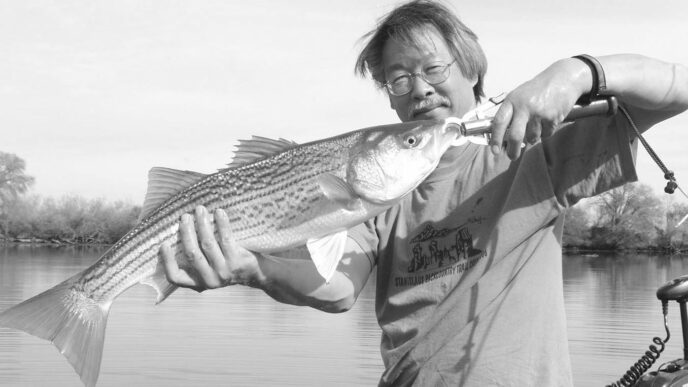I’m floating in a 10-foot flat-bottomed pram, watching the sun set behind distant Mount Shasta. At sundown on the Fall River, the sky bursts with countless shades of orange and yellow, and the methodical, spring-fed current glasses over. As if someone adjusted nature’s sound system, background noise suddenly disappears. In high fidelity, reed tules rattle, fish rise, waterfowl take flight. The stream reflects the sky with such precision that I’m reconsidering which way is up.
For a moment, I forget that Carson Jeffres and Art Teter are sitting next to me. Jeffres works as a river ecologist for the
U.C. Davis Center for Watershed Sciences. Teter just completed his twenty-third year as a fishing guide on the Fall River. Although they just met, Jeffres and Teter have something in common — they can both flat-out fish. Teter knows the hiding place of every fish in the river, and Jeffres spends most of his time with his head underwater, observing how fish feed and make use of different habitat types. Together, these guys are alarmingly effective with a fly rod. Thankfully for the fish, that’s not what this day is about.
This day is about figuring out what’s gone wrong with the Fall River. Art Teter and many others fear that the fishery may soon collapse and take with it one of the best spring-creek angling experiences in California.
The Fall River
The Fall River originates from California’s largest network of cold-water springs. In total, the entire system generates approximately 1,200 to 2,000 cubic feet per second (cfs) of cold, clean water. For perspective, 1,500 cfs converts to about one million acre-feet per year — enough water to sustain over a million families of four for up to one year. All of California requires just over 40 million acre-feet of surface water storage to quench its annual thirst. California’s largest reservoir — Shasta Lake — holds about 4.5 million acre feet. Most Northern California anglers know that the McCloud, upper Sacramento, and Pit Rivers supply the majority of the water flowing into Shasta, but few realize that 85 percent of the summer base flows in the Pit River actually originate in the Fall River. At one million acre-feet per year, the Fall River, not the Pit, supplies an astounding 22 percent of the storage capacity in Shasta Lake. Sitting in our pram, we’re in fact floating atop the largest connected body of cold, clean spring water in California.
But in the ecology of rivers, Jeffres constantly reminds me, “It’s not just the quantity of water that matters, it ’s the quality.” Historically, the water of the Fall River has provided a rich environment for all kinds of wildlife. Its watershed, at over 600 square miles, creates more than 30 miles of ideal cold-water habitat for wild trout, Shasta crayfish, rough sculpins, and a variety of native aquatic plants and macroinvertebrates. With a gradient of less than a foot per mile, the slow, constant, cold current has the potential to support well over 5,000 wild trout per mile. The springs that feed the river also create wetlands and other habitats that support a popular rest stop on the Pacific flyway.
The Problem
All around us, however, warning signs indicate trouble. Through the clear spring water, the river bottom looks like a sandbox: two feet of fine sediment blankets the entire upper river. In the lower river, invasive Eurasian water milfoil grows from bank to bank.
The once world-famous Fall River Ephemerella hatch (Pale Morning Duns) no longer produces what the old-timers remember as snowstorms of mayflies. In select areas, unrestricted cattle trample stream banks. Traces of E-coli and fecal coliform bacteria continue to show up in water samples. The list goes on.
Most of these problems — especially the sediment-related issues — originated with historic land-use practices in the early twentieth century, such as channel straightening, timber harvesting, and livestock management. Others, however, such as the invasive Eurasian water milfoil, have been gradually spreading and getting worse over the last 10 to 15 years. Myriad theories exist regarding the milfoil outbreak, but a general lack of updated science makes it difficult to pinpoint the root cause. Excessive nutrient loading stands out as one possible explanation.
Thankfully, over the last 10 years, private landowners and conservation groups have begun addressing these issues. Todd Sloat, watershed coordinator for the Fall River Resource Conservation District, successfully led a major effort to restore headwater tributaries, the major source of sediment input. The Natural Resource Conservation Service continues to work with landowners to improve ranching and agricultural practices. The Fall River Wild Trout Foundation, led by Michael Fitzwater and Dale Dennis, extensively studied potential solutions for removing excessive sediment. The Shasta Land Trust protected over 400 acres of private riverfront land with conservation easements. California Trout continues to advocate at the state level for improved management of wildtrout waters. Combined, these efforts form a solid foundation for building future conservation programs.
The Fall River Conservancy
This is where the Fall River Conservancy joins the good fight for the Fall River. In 2009, Teter organized a group of local landowners to form a nonprofit organization aptly named the Fall River Conservancy (FRC). In 2010, I joined the FRC to help develop a conservation program to protect the water, lands, and cultural heritage of the valley. For the last year, the FRC has been developing a strategy and raising funds to carry out this mission.
As a nascent organization, the FRC doesn’t claim to know the solutions to the river’s complex problems. We do, however, propose a vision for the future of the valley. As FRC board member Steve McCanne puts it, “We envision making the Fall River Valley the prototypical model in California for how to create a working landscape while still protecting natural resources.” Or as board member Ray Christensen, longtime resident and wild-rice farmer reflects, “Certainly, things have changed — more angling pressure, invasive species, sediment, and land divisions — but one thing that still stands out is the pristine beauty of the Fall River Valley. This must be and can be preserved for future generations.”
Certainly, the FRC wants to solve problems now. However, we recognize that shortcuts and river conservation go together like oil and water. Bad short-term decisions waste money and have unintended consequences. To achieve long-term impacts, the FRC is beginning by trying to untangle the political, social, economic, and ecological complexities of the valley.
Teter and I had invited Jeffres to tour the river with us in hopes of gaining insight into the root factors that affect the health of the river. The U.C. Davis Center for Watershed Science produces some of California’s best ecological research and analysis. Moreover, the center has a proven history of building relationships with landowners in rural conservation environments — an invaluable skill set for getting work done within any ranching community. The FRC hopes the Watershed Center will help us prioritize threats and guide future restoration strategies.
Sitting in the pram at sundown, Jeffres appears interested, but not because Art and I are particularly convincing. From an ecological standpoint, the Fall River speaks for itself. This is an extraordinary place with extraordinary natural resources — an ideal place to develop original research questions and hypotheses. Although degraded, this cold-water habitat still supports biodiversity at remarkable levels. “What if?” we ask ourselves. “What if we could restore this place? What would that mean for California?”
Stakeholders
The Fall River is one of California’s most important sources of cold, clean water. As such, many interests have stakes in it as a resource. From the Pit River watershed and Shasta Lake, the waters of the Fall River flow down the Sacramento and into the Sacramento–San Joaquin Delta. From its sources to the ocean, beyond its own biodiversity and ecology, the water of the Fall River supports multiple industries and enterprises.
Fall River wild rice farmers, for instance, irrigate over 2,500 acres to produce an estimated two to three million pounds of “green” (unprocessed) wild rice per year. It sells at 40 to 90 cents a pound, depending on the year, so the industry pumps as much as $2.3 million a year into the regional economy.
In concert with agricultural operations, PG&E diverts the entire lower Fall River — 1,500 cfs — into a series of hydroelectric plants in one of California’s largest hydropower operations. Utilizing Fall River water, the combined Pit River and Shasta Dam hydroelectric plants generate well over 1,000 megawatts of power — about 7 percent of California’s total hydropower output.
Finally, the federally conceived Central Valley Project draws Fall River water from Shasta to help irrigate a small portion (100,000 acres) of the 3 million acres in agricultural production in the Sacramento–San Joaquin Valley. Worth an estimated $17 billion in 2002, Central Valley agriculture produces 8 percent of the nation’s agriculture output by value. Clearly, Fall River water does not solely irrigate the entire 3 million acres in the Central Valley, but you get the point. From the Modoc Plateau to San Francisco Bay, Fall River water generates major revenue all along the way.
Climate Change and Spring Creeks
In the American West, a region characterized by an arid climate, reliable sources of cold, clean water trump all. Located approximately 50 miles to the east of Mount Shasta, resting atop an immense lava field known as the Modoc Plateau, the Fall River Valley should be bone dry, but it’s not. Instead, dozens of interconnected cold-water springs gurgle to the surface, creating an oasis that serves both people and nature.
From Jeffres’ perspective, cold-water spring-fed ecosystems warrant serious respect in the twenty-first century. “Climate-change scenarios,” he says, “could make this cold water even more valuable than it’s ever been.” The Economist, in the December 2010 issue, projects that the Earth will be at warmer at the end of this century by least 3 degrees Centigrade (4.2 degrees Fahrenheit) than it was at the start of the Industrial Revolution. “Heat waves,” they warn, “will become commonplace and ecosystems will find themselves subject to climates far removed from those they evolved in.”
Spring creeks offer one way to begin to address this problem. Cold-water springs such as the sources of the Fall River offer natural protection in an increasingly hostile environment. Jeffres explains that as runoff-dominated rivers begin running low and warm, spring-fed rivers act as refuges for cold-water species. Research shows that spring-fed rivers resist variation in volume and temperature better than watersheds that rely on surface run-off.
Perhaps this explains why The Nature Conservancy, U.C. Davis, CalTrout, and the Department of Fish and Game have spent millions restoring the cold-water spring habitat of the Shasta River. Flowing northwest from the base of Mount Shasta, the Shasta River may be the last, best hope for struggling coho salmon in the Klamath Basin. Although the Shasta River is tiny in comparison with the Kla-
math River and its well-known tributaries, such as the Trinity and Salmon Rivers, researchers believe that its cold springwater provides the perfect nursery for restoring decimated salmon populations.
Beyond providing a refuge in a warming environment for species that need it, spring-fed systems produce a unique water chemistry that contributes to ecological productivity. In the Shasta Valley, for example, volcanic flows overlie marine sedimentary rocks. As groundwater filters through these rocks, it incorporates nutrients that otherwise wouldn’t exist in runoff-dominated rivers. As a result, the system combines nutrients such as phosphorous and nitrogen with constant cold temperature and a consistent flow. This recipe of stable water temperatures and abundant nutrients grows aquatic plants, bugs, and fish at extraordinary rates.
On the Shasta River, researchers found that 90 cubic feet per second of cold, nutrient-rich springwater and abundant large aquatic plants can produce invertebrate densities that exceed 80,000 individuals per square meter. A tailwater such as the Green River below Flaming Gorge, known by anglers for its productivity, averages only 20,000 individuals per square meter. After working on the Shasta River since 2006, Jeffres can’t help but make comparisons between the Shasta River and the Fall River, with its 1,500 cfs flows, as a bountiful refuge for aquatic cold-water species in a warming world.
A Vision for the Future
Floating in the pram, as our sunset finally dissolves into darkness and we ponder the huge volume of nutrient-rich springwater slowly gliding beneath us, Teter and I redirect the conversation from the world of science back to the reality of trying to restore California’s largest springfed river. We’re hopeful Jeffre’s seen enough to report back to the Watershed Center on why the Fall River deserves attention.
After years of coordinating restoration projects I’m painfully aware of the complexity of water issues and environmental law in California. What can we feasibly accomplish for the Fall River over the next decade? Which issues make sense to address first? Should we advocate for suction dredging the 400,000 cubic yards of fine sand from the upper 12 miles of the river? Should we introduce aquatic weevils (tiny beetles) into the system to eat away at the invasive Eurasian milfoil? The FRC faces many such tough questions.
Jeffres studied with Peter Moyle, the world-famous fish biologist from U.C. Davis. Jeffres tells us that Moyle talks about how river restoration in California should really be thought of as “river reconciliation.” Most rivers in California are already fundamentally and permanently altered in some way. Consequently, river restoration is really about “reconciling” our conservation objectives with realities such as a permanent hydropower infrastructure and municipal and agricultural water demand. How can this be done? Over the last year, the Fall River Conservancy began by forming a strong board of directors — with both locals and outsiders — committed to the long-term restoration of the Fall River Valley. We’ve applied via grant proposals for over $250,000 in private and public funds. These funds, if awarded, will be used for research, on-the-ground restoration projects, the regulatory permit process (for doing in-stream work), and community outreach. We’ve also formed partnerships with entities such as Orvis Inc. and the McConnell Fund, both of which awarded small grants for first-year work. We’ve strengthened our working relationships with natural-resource regulatory agencies, including but not limited to the California Department of Fish and Game, the State Water Board, and the Fall River Resource Conservation District.
Finally, as discussed in this article, we’re working with the U.C. Davis Center for Watershed Sciences and California Trout to ensure that our restoration strategies remain grounded in credible, independent science. As we form a more complete understanding of the driving forces behind the Fall River’s spring-fed ecology, the FRC hopes to design larger, full-scale restoration projects to achieve our vision of the future of the valley.
We believe that the Fall River Valley should be an example in California for managing healthy, working landscapes. We envision restored meadows and marshlands that attract waterfowl by the thousands and functioning cold-water spring systems that support robust populations of large, healthy wild trout. We envision Fall River ranchers continuing to produce healthy crops and livestock while also improving water quality in the river. Perhaps most importantly, the FRC envisions a local community that works together to preserve the priceless way of life, the historic ranches, the large land tracts, and the cultural heritage that survive only by being passed from one generation to the next.
To make a donation or learn more about our efforts to restore the Fall River Valley, please visit our website at http://www.fallriverconservancy.org or send checks to the Fall River Conservancy at 28124 Island Road, Fall River Mills, CA 96028-9717.
















